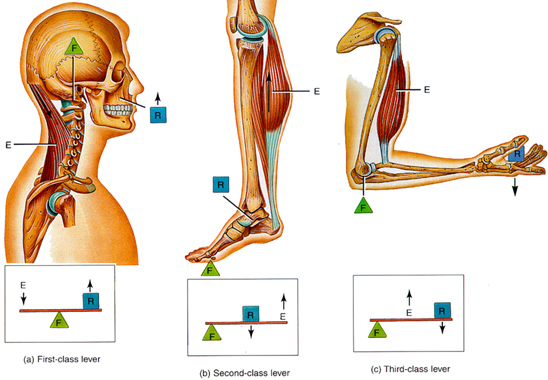| Home | Background |
Levers |
Trade-Offs | Statics |
Mysteries | Bibliography |
Work, Levers and Torque
 Isotonic contractions do
work. Work
is the distance moved in the direction of the force, multiplied by the
force. There is no work done in an isometric contraction.
Isotonic contractions do
work. Work
is the distance moved in the direction of the force, multiplied by the
force. There is no work done in an isometric contraction. W = F*D
Muscles can only contract about 20% of their length. To provide a larger range of motion, levers are used to provide torque . The contracting muscle creates a tension (T) at an angle(θ) to the bone (the moment or lever arm), and at a certain distance(d). This creates a torque (τ) around the joint (the fulcrum).
τ= TSinθ*d
Given a force, the torque is greater when the force is applied further from the joint.
In your arm the
upward muscular
force of the bicep is fairly close to the joint, and the downward
force of an object in your hand is relatively far from the joint.
This means that an object in your hand exerts a much
(http://www.bmb.psu.edu/courses/bisci004a/muscle/musc-img/fig-10.2.jpg)
greater torque downward than your muscle does upward given equal forces.
greater torque downward than your muscle does upward given equal forces.
Your bicep muscle has to provide a much larger force to overcome the torque produced by an object to do work.
Example:

The 5kg mass is 10 times further from the joint than the muscle force, therefore the muscle force has to be at least 10 times greater to do work on the object.
A tension of 550N is applied to move the mass up 10cm.
The work done on the mass is equal to F*h.
550N*0.01m = 5.5 Nm.
Image modified by Kelsey